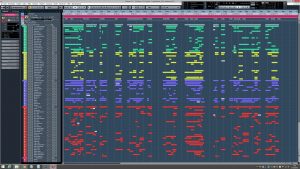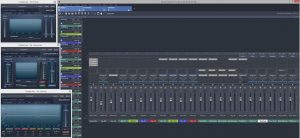Before we go into musical vision, I’d like to share with you some aspects of preparation, particularly two templates that I use.
1. Orchestral MIDI Template
The template which is the most important for me is the MIDI template in Cubase. It represents the symphonic orchestra with all its sections, instruments and articulations. It’s got to be tidy, usable and also inspiring, in the sense of being the one thing I basically look at all the time (besides the video playback window). I’ve made my own template with colors and folder tracks to be really comfortable with, and I don’t want it to get too big. I currently work with 80 tracks, one track being a particular articulation of an instrument, like Violins tremolo or Trumpets muted. You can bloat your template to accomodate two or three times as much, but I’ve found 80 tracks to be a good trade-off (screen showing only orchestral tracks, there are a few for drums and synthesizers which I usually configure when needed).
2. Samples Template
Whereas the MIDI side of things contains all the information (notes, dynamics, tempo etc.), there is also a “hidden” layer behind it that defines the sounds being produced. In this “mixing console” the samples are selected and loaded and effects like EQ, compressor and reverb are applied. MIDI and samples template are closely connected, so parts of that is mirroring the orchestra as laid out in the MIDI template. In addition there are groups and effect buses which make the whole thing quite crowded. However, it’s really the effects, panning and volume settings that are most relevant for “templating”. If you are – as I am – more a composer and less a producer, then you too might avoid spending more time on this side of things than necessary and rather re-use settings which have already proven suitable.
A word of advice for those starting out with sample-based composition and production: Don’t make a template based upon an empty project. You’ve got to work with it and hear the results with an actual composition. Then you change things, adapt and refine – the process never really ends, which is why my templates improve and change from project to project, eventually getting better.
3. Instruments
Looking at those instrument articulations I mentioned earlier, well, those are custom tailored as well. To reduce the number of tracks in my MIDI setup, I combine more than 1 articulation in one instrument and switch between them by inserting particular controller notes that I put outside the range of the instruments, so most of the time they are C1 or C6. This way I switch between vibrato and tremolo strings, muted and normal trumpets, rolling timpani and timpani hits and so on.
4. Shortcuts
It’s not so much about templates, but it falls into the efficiency category as well: I use hot keys whenever possible. The functions I use most are Activate/Deactivate grid, Transpose (by octave), Quantize, Fixed Length and – very important – Change Velocity (which is how “loud and hard” the instrument is to be played – equalling the dynamics from ppp to fff).
Unfortunately there is no shortcut for “make the best mix out of my music”. That would be something! 🙂

